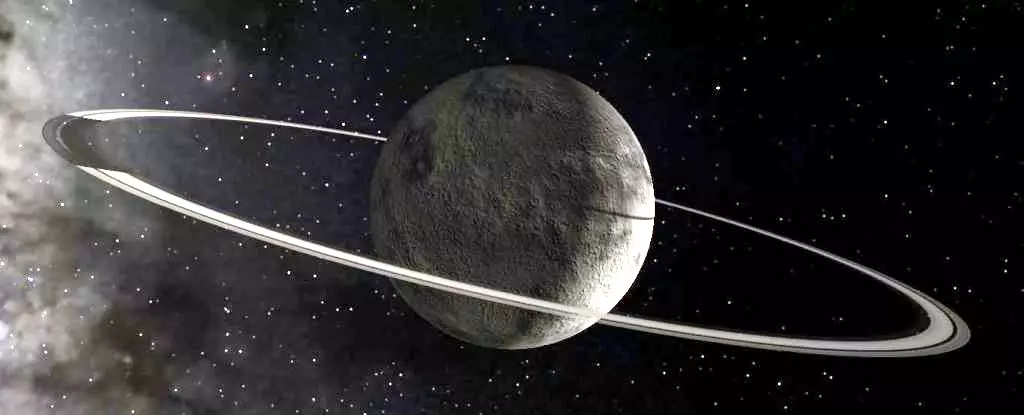Far beyond the familiar orbits of the planets, in the vast expanses of our Solar System, Chiron stands out as a fascinating object of study. Classified as a centaur, a category of celestial bodies residing chiefly between Jupiter and Neptune, Chiron exhibits characteristics that differentiate it from its counterparts. Recent observations from the James Webb Space Telescope (JWST) have sparked excitement within the scientific community, revealing that Chiron possesses traits typical of both asteroids and comets, making it a peculiar anomaly in the realm of celestial mechanics.
Centaurs themselves are intriguing figures in the cosmic ballet, bridging the gap between asteroids and comets. Chiron, however, is distinctive even among this eclectic group. “It’s an oddball compared to most other centaurs,” remarks Charles Schambeau, a physicist affiliated with the University of Central Florida. Its comet-like behavior, the presence of material rings, and a circumstantial debris field evoke a plethora of questions regarding the underlying processes that dictate its unusual characteristics. Such inquiries are paramount for piecing together the narrative of our Solar System’s formation, estimated to have occurred around 4.5 billion years ago.
Planetary scientist Noemí Pinilla-Alonso from the University of Oviedo in Spain leads the charge in probing Chiron’s mysteries. She contends that Chiron serves as a time capsule, containing clues about the conditions during the infancy of the Solar System. “All small bodies in the solar system provide insights into the past,” says Pinilla-Alonso. “Active centaurs like Chiron, undergoing transformations induced by solar heating, provide a unique opportunity for us to examine their surfaces and subsurfaces.”
These transformations are evidenced by Chiron’s remarkable ability to eject both gas and dust, a behavior reminiscent of comets. This comet-like activity prompts scientists to investigate the composition of its coma—the nebulous atmosphere surrounding it. Through the JWST’s advanced capabilities, researchers aimed to analyze the substances making up this gas cloud. Understanding the relationship between the surface ices and the gases in Chiron’s coma is vital for deciphering its physical and chemical properties, including insights into the conditions that have influenced its icy shell over time.
Unraveling Chiron’s Chemical Profile
Utilizing near-infrared observations, Pinilla-Alonso and her team meticulously examined the spectral data collected from Chiron. They focused on identifying absorption and emission lines indicative of the presence of specific chemicals. Previous studies had signaled the existence of compounds such as cyanide and carbon monoxide. Among their findings, the presence of carbon dioxide, ethane, propane, acetylene, methane, and water ice was of particular significance.
The discovery of methane in abundance within Chiron’s coma has provoked particular interest. The implications of this finding deepen the understanding of Chiron’s surface interactions and chemical processes. The jovial reference to “centaur farts” aside, such observations can redefine prior notions about how the ice and gases interact within the unique environment of Chiron.
The Centaur Connection: A Link to Trans-Neptunian Objects
Chiron’s origins lie in a more remote domain of the Solar System, among the trans-Neptunian objects (TNOs) that orbit in the great beyond. TNOs are believed to be among the most pristine remnants from the Solar System’s formation, acting as relics of a time long past. As centaurs like Chiron approach the Sun, the sublimation of their icy constituents commences, enabling the release of ancient materials into their vicinity.
Pinilla-Alonso posits that the observed gases—methane, carbon dioxide, and water ice—may represent elements from Chiron’s primordial composition, suggesting that this centaur could retain vestiges from the Solar System’s early years. Additional compounds like ethane and propane may have originated through chemical alterations occurring on Chiron’s surface, akin to a kind of cosmic rusting process.
The research team intends to continue their observations of Chiron, particularly as it traverses closer to Earth. The evolving nature of Chiron over time offers an invaluable opportunity to glean more insights into the behaviors of these enigmatic icy bodies. Such ongoing studies will help to deepen our understanding of centaurs and may reveal common threads linking the characteristics and behaviors of not just Chiron, but of the entire category of active centaurs.
As research progresses, the mysteries surrounding Chiron are poised to unravel further, potentially revealing its role as a key to understanding the processes that shaped our Solar System. In navigating the cosmos, every new discovery elucidates the intricate tapestry of our celestial neighborhood and underscores the importance of continued exploration. Through the lens of observational astronomy, we remain steadfast in our quest to peer back in time and unlock the narratives written in the stars.


Leave a Reply